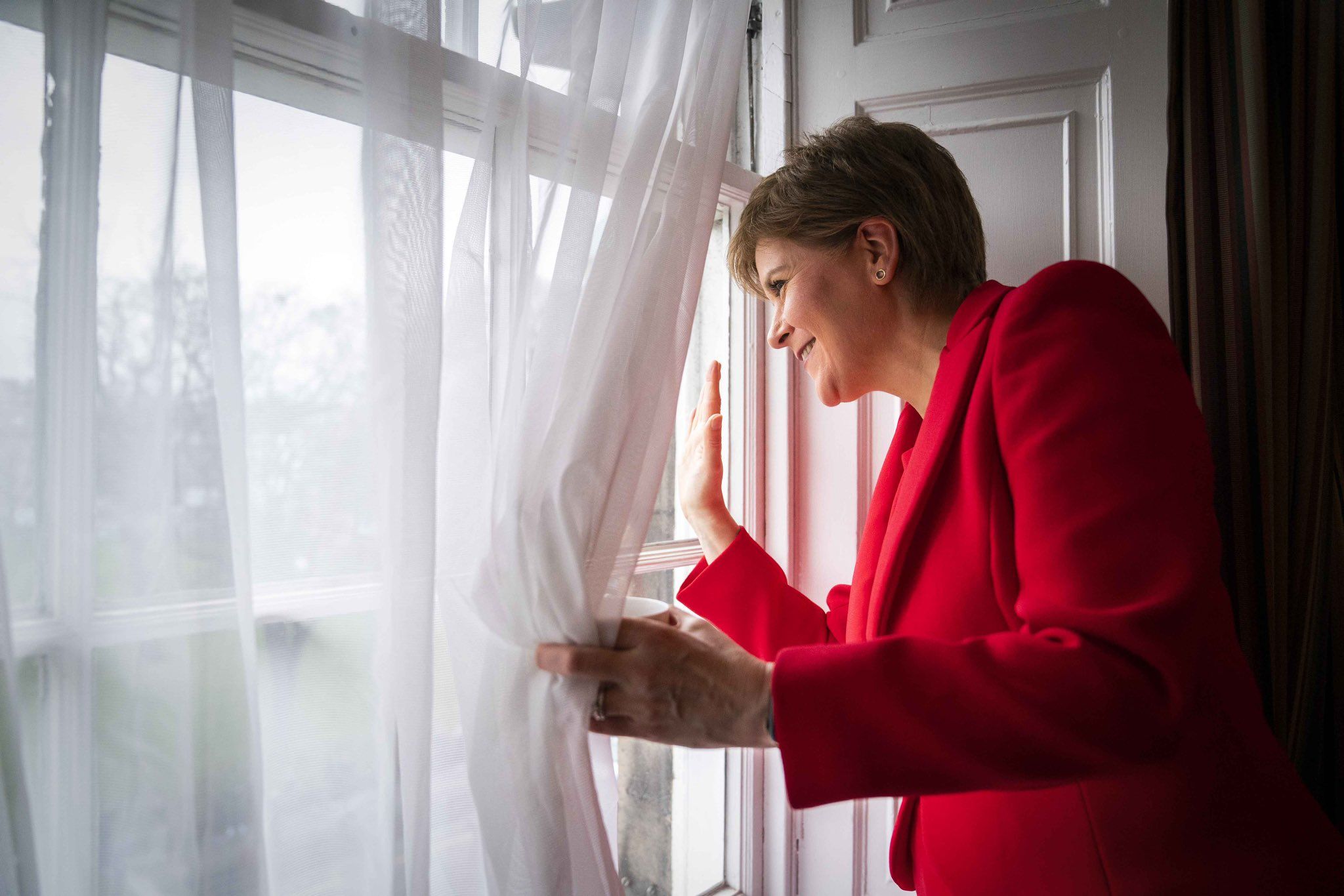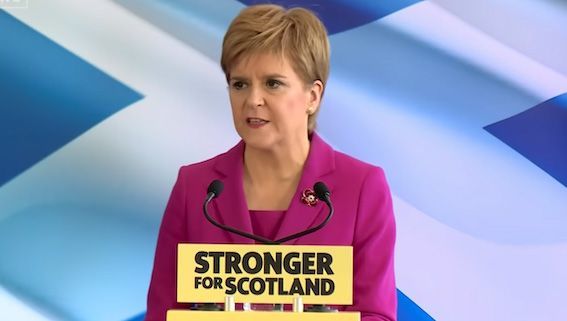A PICTURE, they say, is worth a thousand words, but a cartoon so much more.
There are so many images of Nicola Sturgeon resignation and its impact.
One shows Scotland’s first minister all presidential at her podium, a Saltire behind her shoulder.
Another is a seemingly candid (yet obviously staged) snap of her peeking out the window of her elegant official residence in Edinburgh’s New Town. Below distraught supporters had gathered.
First Minister Nicola Sturgeon waves to people and members of the media gathered outside Bute House in Edinburgh after announcing that she will stand down as First Minister of Scotland after eight years :: #politics #firstminister #nicolasturgeon #snp #edinburgh #scotland pic.twitter.com/0r41bDDrjQ
— Jane Barlow (@belperbarlow) February 15, 2023
Then there are the photos of her most zealous British nationalist opponents, some so delirious that they did a Conga around Glasgow’s central George Square waving mini Union Jacks as they danced.
Some pro-union demonstrators are performing the conga in George Square, Glasgow, chanting “conga, conga, conga, Nicola’s no longer” #HeartNews pic.twitter.com/uawBm6sQvN
— Heart Scotland News (@HeartScotNews) February 15, 2023
But it was a silly little sketch in The Herald newspaper, Scotland’s last broadsheet, that struck me most. It was so simple it needed little explanation.
Cartoonist Stephen Camley drew two giant tartan red pumps. And around them - small, bewildered, sheepish, dishevelled - he depicted Scotland’s other politicians.
Our cartoonist Steven Camley’s take on Sturgeon's resignation https://t.co/hOUfBUlT1Y
— The Herald Politics (@HeraldPols) February 16, 2023
For decades Nicola Sturgeon - mostly in smart shoes - has strode across Scotland’s political stage. She was a hugely influential deputy first minister for seven years and then a dominant FM for another eight.
This leader was - as her classier adversaries acknowledged - a formidable public servant with an astonishing record of winning election after election.
Consider this: Ms Sturgeon, still just 52, has been at the top of power during four US presidencies and seven British premierships.
She was - at the risk of being obvious - also a woman, a working-class one at that. And this brought a different perspective to our politics. Usually a better one, I would say.
In her remarkable and self-aware resignation remarks she talked of her passion for children in care of the state.
Ms Sturgeon - who lost her own child in pregnancy - was remorselessly mocked by her crueller and stupider online critics for being called Scotland’s “chief mammy”.
In truth, the nickname reflected the importance she placed on her job, in law, as the country’s ultimate corporate parent.
"I am a human being as well as a politician"
— BBC News (UK) (@BBCNews) February 15, 2023
Key moments from Nicola Sturgeon's resignation speech https://t.co/7nnwPdF849 pic.twitter.com/JM5VRKepL4
This was Ms Sturgeon at her empathetic best. Her political friends and her foes accepted that the first minister, as she said at her resignation, was a “human being”.
Nicola Sturgeon has been one of the most formidable leaders of our generation.
— Michelle O’Neill (@moneillsf) February 15, 2023
She has led real change as the First Minister of Scotland, and leaves a strong legacy of hope.
It has been a privilege to work with Nicola, standing together for independence and against Tory chaos. pic.twitter.com/5z21YtTetf
I remember one critic, privately, admitting Scotland’s leader, unlike others on the UK stage, was “at least not a sociopath”. Though, this, they added, should surely be a minimum qualification for office.
Ouch! Donald Trump labels Nicola Sturgeon a 'failed woke extremist' as he says 'good riddance' to his old rival.https://t.co/HRm30yUreP
— Scottish Express (@ScotExpress) February 15, 2023
Scotland’s media and political classes are desperately now trying to make sense of Ms Sturgeon’s record. Her longevity makes this hard. There have been so many ups and downs in her governments’ performance over the years.
The SNP leader too will sometimes take the blame - or the credit - for things that are beyond, wholly or partially, the powers of her devolved administration.
Many of the issues that have caused Ms Sturgeon headaches will be familiar to voters almost anywhere: rows over botched procurement programmes (in Scotland’s case, two vitally needed ferries); personal conflicts (for Ms Sturgeon with her predecessor Alex Salmond); and how to handle Culture War topics (here, above all, whether to make it easier for transgender people to change their paperwork).
Her approval ratings have gone up and down over her period in power but have routinely been better than any other leader, in Scotland or elsewhere in the UK. How do they stand just now? Well, the trans row does seem to have turned some people against the First Minister.
Here's how Nicola Sturgeon has fared with the public over her time as FM.
— Emily Gray (@EmilyIpsosScot) February 16, 2023
Underlines how well her leadership/communication style were received during the pandemic, & the recent dip in her ratings in context of the gender recognition reforms row and divisions over indy strategy. pic.twitter.com/gk7lapykyA
A snap poll carried out after her resignation found 52 per cent of Scots thought Ms Sturgeon had been a good FM. But 39 per cent said she had been “bad’.
📊Post-resignation poll from @YouGov
— Mark McGeoghegan (@markmcgeoghegan) February 15, 2023
'Do you believe Nicola Sturgeon has been a good or a bad First Minister of Scotland?'
Good: 53%
Bad: 39%
DK: 8%
In YouGov's last poll to ask about her performance, in December, 52% said she was doing well, 39% badlyhttps://t.co/f2qNQR715E
I do not think popularity ratings tell the whole story. They do not fully express the intensity of feelings Ms Sturgeon inspires among Scots.
Some of her detractors hate her with an almost deranged passion. Her success has spawned bizarre conspiracy theories and industrial scale, bilious social media abuse. Equally, there are supporters of Ms Sturgeon who simply adore her. Some openly cried when she resigned.
‘Nicola Sturgeon was a friend of Ireland’: Departing Scottish first minister praised by Irish politicians https://t.co/wMoNGo5ssK
— Neale Richmond (@nealerichmond) February 15, 2023
I am not going to pretend to know how historians will remember Ms Sturgeon. But her name and her legacy will likely to be tied to a single issue: independence. And it is this cause - that of her entire life since she began campaigning for the SNP aged 16 - that makes her both so loved and so detested.
It is worth repeating her own words when she resigned.
“I am firmly of the view that there is now majority support for independence,” she said.
“But that support needs to be solidified - and it needs to grow further if our independent Scotland is to have the best possible foundation.
“To achieve that we must reach across the divide in Scottish politics.
“And my judgment now is that a new leader will be better able to do this. Someone about whom the mind of almost everyone in the country is not already made up, for better or worse.
“Someone who is not subject to quite the same polarised opinions, fair or unfair, as I now am.
“The good news - as the country will now get to see more clearly perhaps - is that the SNP is full of talented individuals more than up to that task.”
These remarks provoke two questions.
The first: Is there really a majority for independence? Well, after a decade and a half of SNP rule, the answer appears to be no. Not a sustained, enduring one, anyway, not yet.
The second question: Are there really great leaders ready to appear from under Ms Sturgeon’s shadow? Or, as in the Camley drawing, peeking out from behind her shoes? We do not know yet.
There are unionist commentators celebrating Ms Sturgeon’s departure.
Nicola Sturgeon's career-long mission has ended in failure. (Me for @thetimes) https://t.co/TeySin49mo
— Iain Martin (@iainmartin1) February 15, 2023
Their theory: that the independence movement has been decapitated, that without its great communicator it will fizzle out.
Maybe. But I believe there is a real danger here of seeing Scottish politics through a Great Man - or Woman - Theory.
Just because a London commentator has only heard of Nicola Sturgeon does not mean there are not other nationalist voices.
A warning for comrades on the Unionist side… pic.twitter.com/5qyJp6ZFZ3
— Cat Headley (@Cat_Headley) February 15, 2023
Independence was never about one person. Nor for that matter, was union.
There are long-term structural changes in how many Scots view their place in the world and these are not going to vanish with a change of leadership in government or party.
Cartoons are great. But let us not mistake caricature for analysis.








